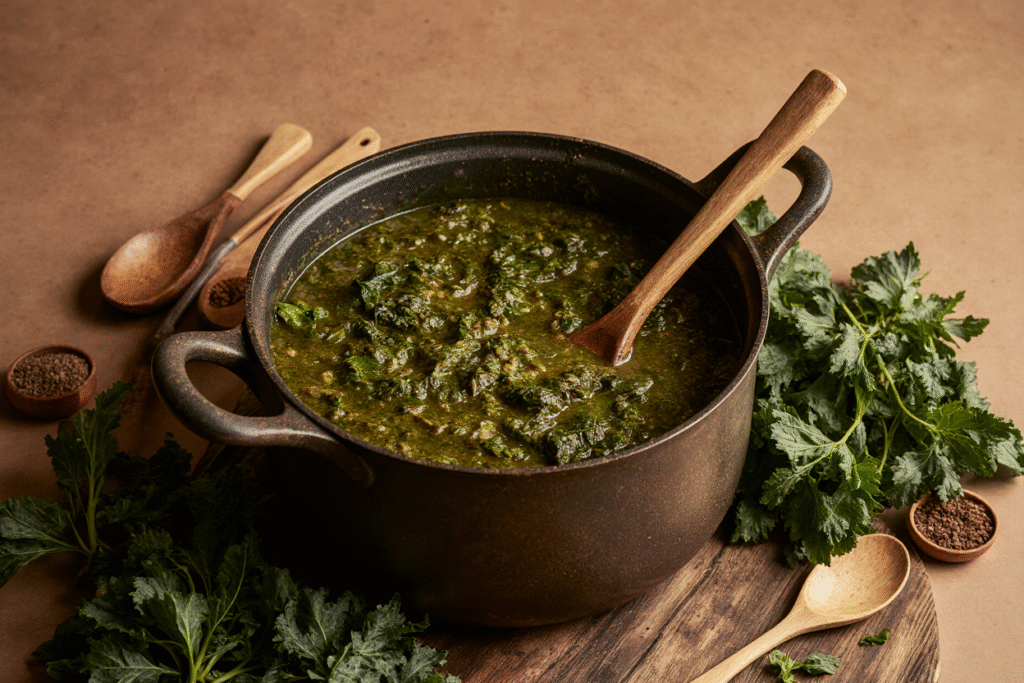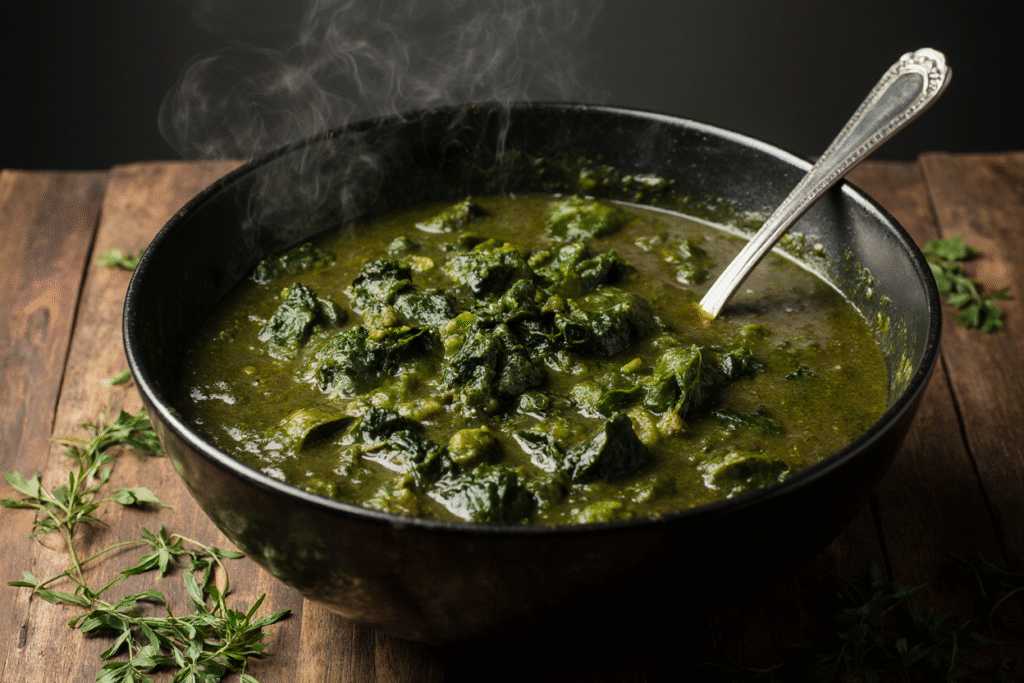Table of Contents
Step into any traditional Louisiana kitchen during Lent, and you’ll likely encounter the incredible aroma of gumbo z’herbes simmering on the stove. This remarkable green gumbo represents one of the most authentic expressions of Creole cooking – a dish so deeply rooted in Louisiana’s cultural heritage that it tells the story of resilience, creativity, and the beautiful fusion of African, French, and Native American culinary traditions.
Unlike the more familiar seafood or chicken gumbos that have gained widespread popularity, this green gumbo recipe showcases the incredible versatility of leafy vegetables. We’re talking about transforming humble greens like kale, collard greens, beet greens, and numerous other varieties into a rich, flavorful stew that’s both deeply satisfying and incredibly nutritious. The result is a dish that proves vegetables can be just as hearty and soul-warming as any meat-based meal.

The Cultural Significance Behind Every Bowl
Gumbo z’herbes isn’t just food – it’s living history served in a bowl. This traditional Creole dish emerged from the practical necessity of making the most of available ingredients during challenging times. The name itself tells the story: “z’herbes” is a Creole French term meaning “with herbs” or “with greens,” though in this context, we’re talking about much more than simple herbs.
Historically, this green gumbo was particularly popular during Lent when many families abstained from meat. However, calling it merely a “Lenten dish” undersells its significance. This recipe represents the ingenious way Creole cooks transformed whatever greens they could find – whether from their gardens, foraged from the wild, or purchased at local markets – into something extraordinary.
The traditional preparation often involved using at least seven different types of greens, though some families insisted on nine or even more varieties. Each green contributed its own unique flavor profile and nutritional benefits, creating a complex, layered taste that develops beautifully as the gumbo simmers. This wasn’t just about sustenance; it was about creating something delicious from simple, accessible ingredients.
Building Your Green Foundation
The magic of gumbo z’herbes begins with selecting the right combination of greens. While you might be tempted to stick with familiar options like spinach or lettuce, authentic green gumbo demands more adventurous choices. Collard greens provide a sturdy, slightly bitter foundation that holds up beautifully during long cooking times. Kale adds earthiness and substantial texture, while beet greens contribute a subtle sweetness that balances more assertive flavors.
Don’t overlook mustard greens, which bring a pleasant peppery bite that awakens the palate. Turnip greens offer their own unique character, with a slight sharpness that complements the other vegetables perfectly. Swiss chard, with its colorful stems and mild flavor, adds visual appeal and gentle taste. Some traditional recipes include wild greens like lamb’s quarters or purslane when available, connecting the dish to its foraged roots.
The key to exceptional gumbo z’herbes lies in understanding how different greens behave during cooking. Tender leaves like spinach or arugula should be added later in the process to prevent them from becoming mushy. Heartier greens like collards or kale can withstand longer cooking times and actually benefit from extended simmering, which breaks down their tough fibers and allows their flavors to meld with the other ingredients.
The Art of the Roux
No authentic gumbo exists without a proper roux, and green gumbo is no exception. The roux serves as both a thickening agent and a flavor foundation, providing the rich, nutty undertones that make gumbo so distinctive. For gumbo z’herbes, you’ll want to develop a medium-brown roux – darker than what you might use for a white sauce, but not as dark as what’s traditional for seafood gumbo.
Creating the perfect roux requires patience and constant attention. You’re essentially cooking flour and oil together until the mixture reaches the desired color and develops its characteristic nutty aroma. This process can take anywhere from fifteen to thirty minutes, depending on your heat level and desired darkness. The roux should smell toasty and inviting, never burnt or acrid.

Some cooks prefer to make their roux in the oven, which reduces the risk of burning and allows for more consistent results. Others swear by the stovetop method, claiming it provides better control over the development process. Regardless of your chosen method, remember that roux continues to cook even after you remove it from direct heat, so stop cooking just before it reaches your desired color.
Layering Flavors Like a Master
The beauty of traditional gumbo z’herbes lies in the careful layering of flavors that develops throughout the cooking process. After your roux is ready, the next step involves building your vegetable base, often called the “holy trinity” in Creole cooking – onions, celery, and bell peppers. These aromatics provide the flavor foundation upon which everything else builds.
Garlic comes next, adding its pungent warmth to the mixture. Some recipes include shallots or leeks for additional complexity. The vegetables should be cooked until they’re soft and fragrant, allowing their flavors to concentrate and meld with the roux. This process, known as “sweating,” releases the natural sugars in the vegetables and creates a more complex flavor profile.
Seasoning plays a crucial role in authentic gumbo z’herbes. Bay leaves are essential, providing an earthy depth that complements the greens beautifully. Thyme adds an herbal note that bridges the gap between the aromatics and the leafy vegetables. Cayenne pepper provides heat, though the amount can be adjusted based on personal preference. Some families include their own special spice blends passed down through generations.
The Slow Simmer Secret
Once your greens join the party, patience becomes your greatest ally. Gumbo z’herbes isn’t a dish you can rush. The slow simmering process allows the tough fibers in heartier greens to break down completely, creating a silky, cohesive texture that’s absolutely divine. During this time, the flavors from all the different greens meld together, creating something far more complex than the sum of its parts.
The cooking liquid – whether you use vegetable stock, water, or a combination – should be added gradually. The gumbo should have a consistency that’s thicker than soup but thinner than stew. It should coat the back of a spoon but still flow freely. Achieving this perfect consistency requires attention and occasional stirring to prevent sticking.
Modern Adaptations and Serving Suggestions
While tradition forms the backbone of great gumbo z’herbes, modern cooks have found ways to adapt the recipe for contemporary kitchens and dietary preferences. Some versions include protein additions like smoked turkey or andouille sausage, though purists argue this changes the essential character of the dish. Vegetarian and vegan versions have gained popularity, proving that this green gumbo can satisfy a wide range of dietary needs.
The traditional serving method involves ladling the gumbo over steamed white rice, which helps absorb the flavorful broth and provides a neutral base that doesn’t compete with the complex vegetable flavors. Some families serve it with cornbread or French bread for sopping up every last drop of the delicious liquid.
Preserving Culinary Heritage
Making gumbo z’herbes connects you to generations of cooks who understood that exceptional food doesn’t require expensive ingredients – it requires respect for tradition, patience, and an understanding of how simple ingredients can be transformed into something magnificent. Every pot of this green gumbo carries forward the wisdom of cooks who knew how to create abundance from simplicity, turning humble greens into a dish worthy of celebration.

This recipe represents more than just a meal; it’s a celebration of resourcefulness, community, and the enduring power of traditional cooking to nourish both body and spirit.



